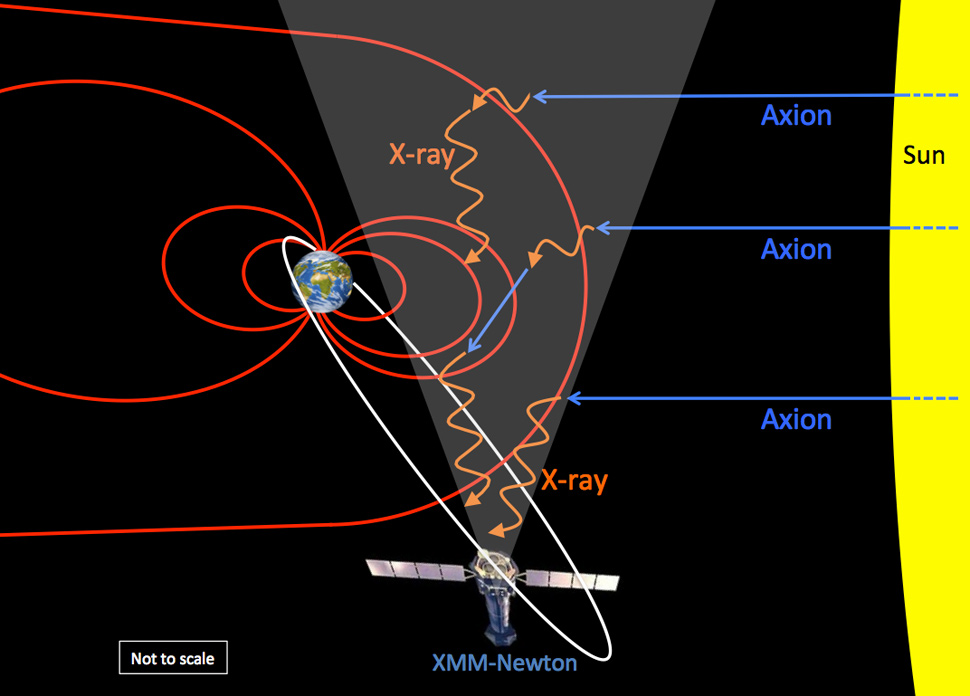Axions: The Key to Understanding Dark Matter
Axions are an exciting area of research within particle physics, serving as leading candidates for dark matter, the elusive substance that makes up a significant portion of the universe. Despite being unseen, axions have captivated scientists’ imaginations as potential building blocks that could explain fundamental questions about the cosmos. Recent breakthroughs in quasiparticle detection, particularly involving axion quasiparticles, have enhanced our understanding of these particles and their role in the universe. These developments not only advance theoretical physics but also open the door for innovative quantum technologies that could revolutionize our approach to particle interactions. As researchers continue to unravel the mysteries of axions, we move closer to confirming their existence and unlocking the secrets of dark matter.
In the quest to uncover the fundamental elements of our universe, researchers are delving into theoretical entities known as axions. These hypothetical particles are postulated to account for the vast majority of dark matter that permeates the cosmos, challenging our understanding of particle physics. Furthermore, the study of quasiparticle behavior and their interactions with axions is paving the way for promising new technologies in quantum mechanics. The intricate relationship between axions and these quasiparticles represents a significant frontier in modern physics, inviting further exploration into the nature of cosmic phenomena. As we continue to unravel these complexities, the potential for groundbreaking discoveries in the fields of cosmology and materials science becomes increasingly tangible.
Understanding Dark Matter and Its Connection to Axions
Dark matter is one of the universe’s most enigmatic components, accounting for approximately 85% of its mass. Despite its substantial presence, it remains undetected directly, challenging physicists to uncover its nature. The search for dark matter has garnered widespread attention, with axions emerging as a leading candidate in this cosmic mystery. Axions, theorized as lightweight quasiparticles, could play an essential role in elucidating the formation of structures in the universe and enhancing our comprehension of particle physics.
The connection between dark matter and axions is rooted in theoretical physics. First proposed decades ago, axions were introduced to resolve the strong CP problem in quantum chromodynamics. Their significance has been amplified as scientists investigate dark matter’s elusive characteristics. Researchers are now harnessing cutting-edge techniques to detect these theoretical particles, positioning axions at the forefront of dark matter research. By identifying axions, scientists could not only confirm their existence but also obtain critical insights into the makeup of the cosmos.
The Role of Axion Quasiparticles in Experimental Physics
Axion quasiparticles serve as a groundbreaking tool in experimental physics, providing a novel approach to detecting dark matter. These quasiparticles, simulations of actual axions, allow researchers to explore the dynamic interactions of particles at a fundamental level. By utilizing materials like manganese bismuth telluride, scientists can create environments conducive to the study of axion quasiparticle behavior. Such innovations pave the way for more advanced detection methodologies, enhancing our ability to uncover the hidden constituents of dark matter.
The experimental journey to understanding axion quasiparticles involves meticulous engineering and sophisticated measurement techniques. Researchers have tailored the properties of manganese bismuth telluride to observe the interactions that occur when a potential dark matter axion collides with the material. Through precision measurement, the team could track the excitation of quasiparticles, providing empirical evidence of axion behavior. This methodology not only confirms theoretical predictions but opens new avenues for quantum technologies that may further explore the implications of particles within dark matter research.
Harnessing Quantum Technologies for Dark Matter Research
Quantum technologies are revolutionizing various fields, including particle physics, and their application in dark matter research is particularly promising. By optimizing experimental setups to utilize innovations such as ultrafast laser optics, scientists are unlocking the potential of axion quasiparticles as detectors. The integration of quantum materials enables researchers to delve into the core interactions of particles and their properties, heightening the sensitivity required to identify elusive dark matter signals.
The exploration of quantum technologies also encompasses the development of new light-matter interactions facilitated by axion polaritons. This emerging field can yield significant breakthroughs in both experimental physics and potential applications across various industries. As researchers continue to refine their techniques and experiment with the fundamental properties of axion quasiparticles, the implications for our understanding of dark matter could be profound, shaping future advancements in quantum technologies.
The Interdisciplinary Approach to Axion Research
The successful investigation of axions requires a highly interdisciplinary approach that bridges several scientific domains, including condensed matter physics, material chemistry, and high-energy physics. This convergence of disciplines is essential for crafting experiments that probe the fundamental particles believed to comprise dark matter. The collaborative effort among researchers from prestigious institutions illustrates how pooling knowledge and expertise can advance the frontiers of particle physics.
Facilitating teamwork among experts enables more comprehensive experimental designs that can tackle complex questions surrounding dark matter. As researchers like Jian-Xiang Qiu and Suyang Xu lead the charge in utilizing axion quasiparticles, they exemplify the significance of interdisciplinary collaboration in achieving breakthroughs. This synergy will not only deepen our understanding of axions but also potentially unveil new technologies that can emerge from exploring the quantum regime of particle physics.
Future Prospects for Axion Detection
The future of axion detection holds immense promise as researchers develop increasingly sophisticated techniques to identify these elusive particles. With ambitious goals set for impending experiments, physicists believe they are on the verge of a significant breakthrough in dark matter research. The advancement of methodologies that tune into specific frequencies emitted by axions positions the scientific community closer to confirming their existence, thus unraveling a critical piece of the universe’s puzzle.
As teams continue to refine the experimental environments, the intersection of particle physics and cosmic exploration becomes clearer. If successful, these endeavors could reveal not only the nature of dark matter but also reshape theories of fundamental physics. The combination of cutting-edge technology, innovative materials, and collaborative spirit prepares the scientific community for perhaps the most exciting discoveries in modern physics.
The Importance of Axions in Cosmology
Axions play a pivotal role in our understanding of cosmology, particularly in explaining phenomena related to dark matter. As one of the leading candidates for this mysterious substance, axions carry the potential to enlighten scientists regarding the universe’s evolution and structure formation. Their hypothetical interactions with other particles could provide clues as to why galaxies form and how they evolve over cosmic time.
By studying axions, researchers can test fundamental theories that underpin our comprehension of gravity and matter in the universe. If experiments succeed in detecting these quasiparticles, the resulting data could refine our cosmological models and lead to a new paradigm in understanding the cosmos. The implications of confirming axions as a dark matter candidate extend far beyond particle physics, potentially transforming various allied disciplines such as astronomy and astrophysics.
Technical Innovations in Axion Research
The recent advances in axion research highlight a wave of technical innovations that facilitate the detection and analysis of quasiparticle behavior. Researchers employ highly refined techniques, such as nanofabrication, to create two-dimensional crystal structures that can support axion quasiparticles. These novel materials exhibit unique electronic and magnetic properties, thus enhancing their suitability for experiments aimed at uncovering dark matter.
Moreover, sophisticated measurement tools have been developed to analyze the subtle dynamics of axion quasiparticles. By employing ultrafast laser systems, scientists can observe the changes induced by potential dark matter interactions with remarkable precision. This blend of technical prowess and theoretical insight accelerates progress in the quest for understanding dark matter, showcasing the role of innovation in today’s scientific endeavors.
Impact of Axion Research on Future Quantum Technologies
The impact of axion research on future quantum technologies cannot be overstated. As scientists delve deeper into the properties and applications of axion quasiparticles, the potential for new technological advancements expands exponentially. The interaction of light and matter facilitated by axion polaritons can lead to groundbreaking discoveries, influencing various fields ranging from computing to telecommunications.
By leveraging the insights gained from axion studies, researchers aim to develop quantum devices that can operate beyond the capabilities of classical technologies. These innovations could revolutionize how we approach problems in particle physics and beyond, illustrating the intertwined relationship between fundamental research and technological evolution. The future of quantum technologies is intricately linked to axion research, with the prospect of not only understanding dark matter but also powering the next generation of scientific advancements.
Collaborative Efforts in Axion Research Across Institutions
Collaborative efforts across institutions have proven to be instrumental in the progress of axion research. With contributions from various universities and research centers, such as Harvard, King’s College London, and UC Berkeley, a rich diversity of expertise is brought to the table. This shared knowledge and resources allow for more ambitious projects and intricate experiments aimed at understanding the complex nature of dark matter and axions.
The collective aim is not just to confirm the existence of axions but to explore their properties and potential applications in quantum technologies. As scientists from different backgrounds unite, they foster an environment conducive to innovation, propelling both theoretical predictions and experimental validations. This collaborative spirit underscores the importance of teamwork in tackling some of the most formidable challenges in modern physics.
Frequently Asked Questions
What are axions and how do they relate to dark matter?
Axions are hypothetical particles in the realm of particle physics, proposed as a candidate for dark matter. They are theorized to be a fundamental component that accounts for the unseen mass in the universe. If confirmed, axions could provide critical insights into the nature of dark matter and its role in the universe’s structure.
How might axion quasiparticles help in detecting dark matter?
Axion quasiparticles are simulations of axions created in certain materials. Researchers utilize these quasiparticles to detect actual axions by observing the reactions that occur when a dark matter axion interacts with the material. This innovative approach could lead to more effective dark matter detection technologies.
What recent advancements have been made in the study of axions?
Recent advancements include groundbreaking experiments by scientists from Harvard and King’s College London, who have successfully demonstrated the creation and detection of axion quasiparticles. This breakthrough aids in confirming the existence of axions and poses new possibilities for dark matter detection and quantum technologies.
What role do quasiparticles play in quantum technologies related to axions?
Quasiparticles, like axion quasiparticles, serve as crucial tools in quantum technologies. They can simulate axion interactions in controlled environments, allowing researchers to explore their quantum properties and develop new applications in areas such as quantum computing and sensing.
Why are axions considered a significant aspect of particle physics research?
Axions are significant because they propose a solution to one of the biggest mysteries in physics: the nature of dark matter. Their study could refine our understanding of the universe’s composition and advance theoretical frameworks in particle physics, contributing to the quest for a unified theory.
What materials are used for creating axion quasiparticles?
Researchers have utilized materials like manganese bismuth telluride, known for their unique electronic and magnetic properties, to create axion quasiparticles. These materials are engineered into a 2D crystal structure that serves as an ideal platform for studying the dynamics of axion quasiparticles.
What is the future outlook for axion research in relation to dark matter detection?
The future of axion research looks promising, with ongoing efforts to refine experimental conditions and techniques for better detection of dark matter axions. Scientists aim to further explore axion quasiparticle properties, which may lead to groundbreaking developments in both particle physics and dark matter detection technologies.
Who are the leading researchers in the field of axions and dark matter?
The field of axion research is led by a team of scientists including Jian-Xiang Qiu from Harvard University, Suyang Xu, and notable physicist Frank Wilczek, who originally proposed axions. Their collaborative efforts highlight the interdisciplinary nature of this research, involving condensed matter physics and high-energy physics.
What challenges remain in the hunt for axions as dark matter candidates?
Despite advancements, challenges remain in conclusively detecting axions. These include the need for precision instruments to capture subtle signals from dark matter axions and the complex nature of the quantum materials involved in axion quasiparticle research.
How does this research on axions impact our understanding of the universe?
Research on axions could revolutionize our understanding of the universe by potentially confirming the existence of dark matter and providing insights into the universe’s overall composition and history. It shapes our grasp of fundamental physics and may lead to new scientific discoveries.
| Key Points |
|---|
| Axions are hypothetical particles proposed to explain dark matter and address fundamental questions in physics. |
| A recent experiment by Harvard and King’s College London demonstrated a method to detect axion quasiparticles, which simulate axion behavior. |
| The study utilized manganese bismuth telluride, forming a 2D crystal structure to enhance axion quasiparticle creation and observation. |
| Researchers have explored the dynamic behavior of these quasiparticles, aiming to develop new technologies and dark matter detection methods. |
| The research represents a significant step toward confirming the existence of axions as a leading candidate for dark matter. |
| Future experiments are planned to refine detectors for axion dark matter, aiming to aid the broader physics community. |
Summary
Axions are a crucial research focus as scientists strive to unravel the mysteries of dark matter in the universe. The recent groundbreaking experiments not only bring us closer to confirming their existence but also open up new avenues for technological advancements in quantum materials. By harnessing the behavior of axion quasiparticles, researchers could potentially develop highly sensitive dark matter detectors and contribute significantly to our understanding of the cosmos.



